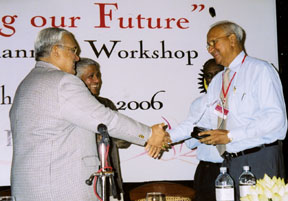|
observer |
|
|
|
|
|
OTHER LINKS |

|

|

|
Anura decries BBC and CNN reportsMinister of Tourism Anura Bandaranaike was vociferous in condemnation of the BBC and CNN reports of October, on naval personnel coming under a suicide attack in Dambulla, north central Sri Lanka and the naval base in Galle, in the island's south.
The minister's disagreement was on grounds of sensational motivation by the international television channels. "As a Sri Lankan, my hairs stood on end, seeing the burning human bodies, shown," the minister told tour operators and travel agents, from overseas and here, when he addressed a workshop on "Building our future" at Taj Exotica, Bentota. The BBC report had depicted Sri Lanka as an unsafe place for tourists. But, the minister said that there was not a single case in Sri Lanka where a tourist had been targeted by terrorists. In the Central Bank targeted bomb of 1996 and 'Galadari bomb' of 1997, a few tourists who happened to be in the vicinity, got injured. But, Sri Lanka is 25,000 square miles in extent, and tourists had never been targeted, here. There are cases of tourists being killed in cold blood in Egypt and the massive bomb blast in Bali, Indonesia, which targeted Australian tourists. But, no tourist has been targeted in Sri Lanka. The tourism minister said that the English are a decent people. When in London, for the World Travel Mart, in November he would speak to BBC, he said. The minister's speech apart, the October 1997, 'Galadari bomb' was intended to knock out the computer in the Colombo Stock Exchange (CSE) on the third floor of the World Trade Centre, adjoining the Galadari Hotel. The bomb shattered the CSE computer, with all the data of the 250 listed companies and all information of locals and foreigners who held CSE stocks. The computer cost over Rs 100 million, (Rs. 84 to a US dollar at the time). Trading was suspended. The backup computer was not destroyed and trading resumed. CNN missed this feature of the CSE story, but claimed that the 36 storeyed World Trade Centre (where the CSE is housed) was raised to the ground. The report even quoted the owners, saying that they would rebuild the World Trade Centre, on the same spot. The World Trade Centre, held by Overseas Realty Ltd, a Singaporean company, has not been rebuilt and stands firm, as ever, in testimony of sensational CNN reporting of October 1997. The same Singaporean investor will now build a mega city in Colombo 6. Chairman, Sri Lanka Tourist Board, Udaya Nanayakkara said that Sri Lanka as a tourist destination had in the past gone through severe obstacles, crisis after crisis, yet, remained resilient. Now, Sri Lanka tourism must strategise itself, for a better future, while being geared for unpredictable business environments. The meeting in review was to initiate a process to prepare a three-year strategic marketing plan and a one-year operational plan with the assistance of all stakeholders. Willie Weerasekera, a management and marketing consultant, domiciled in Australia, conducted the sessions, on an honorary basis. International and local experts on destination branding, integrated marketing and other disciplines tried to agree on whether Sri Lanka needed a new branding strategy and a new tourism logo. Case studies of other destinations were also discussed. Sri Lanka as a tourist destination was facing challenges from all over the world; marketing and strategies were changing, Nanayakkara said. A recent airport survey carried out by SLTB showed that 62.7 percent of visitors had obtained information to visit Sri Lanka on the internet. The overall average tourist spent per day in 2005 was $83.41. Japan, was the highest spending market, with $107.9 per day followed by Australia with $101.3 per day. By 2010 the target could be, $155 per day. The objective of the workshop is to establish a process for a specific outcome by bringing skills and knowledge of the stakeholders of the industry. Specially a gap analysis approach to analyse the current scenario and find suitable strategies to reach the overall objective of Sri Lanka tourism. The CIM marketeers are also engaged in drawing up the plan, with SLTB experts. Ensuring transparency, the document is expected to be completed by the end of next month. |









